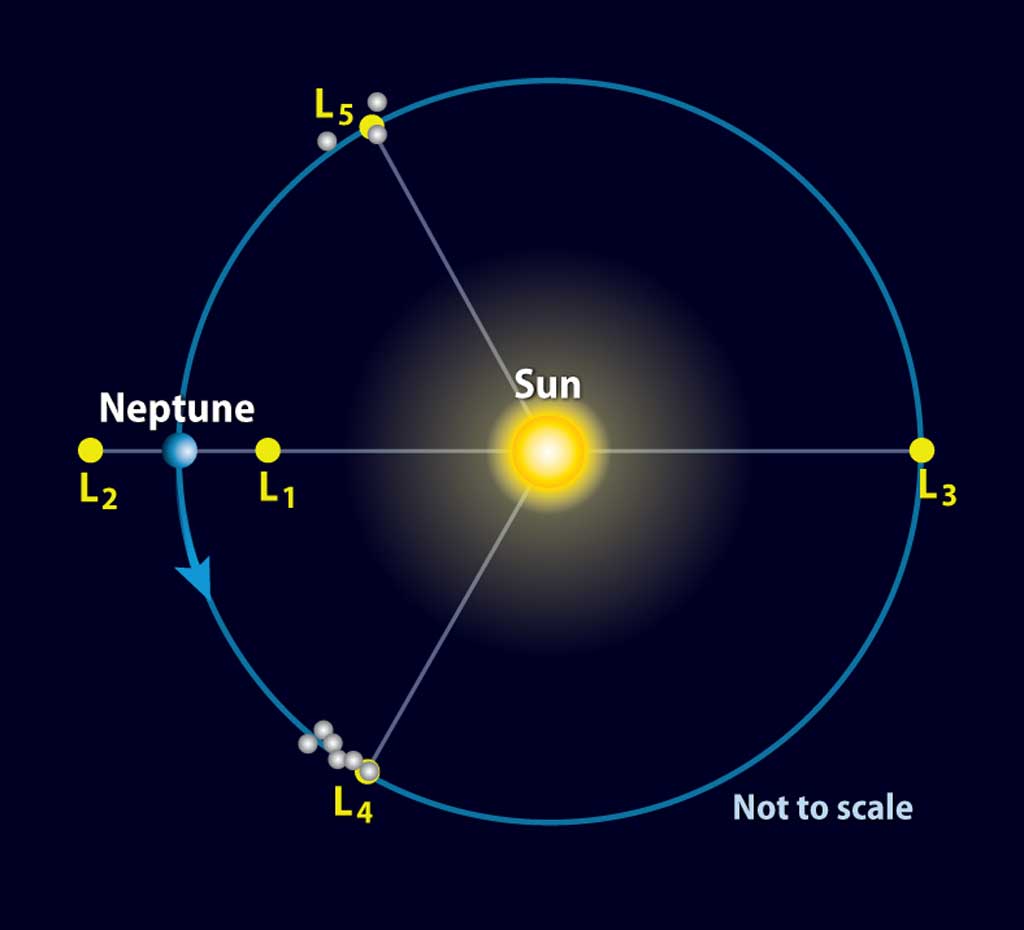Neptune’s and the Sun’s gravity balance out in five regions; each planet has five such areas with respect to our star (labeled L1 through L5). In Neptune’s L4 area, six Trojan asteroids orbit the Sun ahead of the world. (In the planet’s L5 region, three such asteroids trail Neptune in its orbit around our star.) Both Neptune’s L4 and L5 span about 2 billion miles (3.2 billion kilometers), and thus the asteroids have enough room to move within the area that collisions are extremely rare. // Astronomy: Roen Kelly, after Scott Sheppard (CIW)
The gravity of a planet, its star, and the centrifugal force associated with the planetary orbit nearly balance in five regions near the planet’s path where an asteroid (or spacecraft) could orbit safely. These areas are nicknamed L1 through L5 after the French mathematician Joseph Lagrange, the first to catalog all five points.
Calculations show us that a planet’s gravity can often destabilize the orbits of nearby asteroids and comets, flinging them away or sending them crashing into the Sun or into that planet. Some also could be captured within one of the stable regions. Neptune’s L4 area spans a large region in space, and it has a lot of room for Trojan asteroids to orbit within and not crash into each other. The objects in these orbits span a zone about 30° across as viewed from the Sun (see illustration above). Given that these orbits are at about the same distance from the Sun as Neptune, L4 spans about 2 billion miles (3.2 billion kilometers), or about 22 times the radius of Earth’s orbit, for example.
We have discovered only a handful of Neptune Trojans, but we think the ones we see are just the tip of the iceberg, so to speak; there are probably many more smaller asteroids orbiting in the L4 region, and these plentiful small objects may indeed collide over billions of years. We’re also not certain exactly how the Neptune Trojans formed, but colliding asteroids that break apart may have played a role.
Calculations show us that a planet’s gravity can often destabilize the orbits of nearby asteroids and comets, flinging them away or sending them crashing into the Sun or into that planet. Some also could be captured within one of the stable regions. Neptune’s L4 area spans a large region in space, and it has a lot of room for Trojan asteroids to orbit within and not crash into each other. The objects in these orbits span a zone about 30° across as viewed from the Sun (see illustration above). Given that these orbits are at about the same distance from the Sun as Neptune, L4 spans about 2 billion miles (3.2 billion kilometers), or about 22 times the radius of Earth’s orbit, for example.
We have discovered only a handful of Neptune Trojans, but we think the ones we see are just the tip of the iceberg, so to speak; there are probably many more smaller asteroids orbiting in the L4 region, and these plentiful small objects may indeed collide over billions of years. We’re also not certain exactly how the Neptune Trojans formed, but colliding asteroids that break apart may have played a role.
Marc Kuchner
NASA’s Goddard Space Flight
Center, Greenbelt, Maryland
NASA’s Goddard Space Flight
Center, Greenbelt, Maryland










